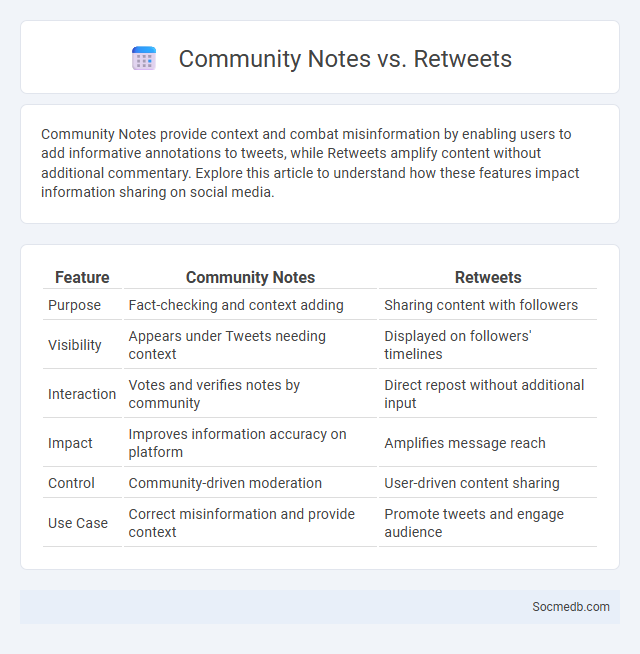
Photo illustration: Community Notes vs Retweets
Community Notes provide context and combat misinformation by enabling users to add informative annotations to tweets, while Retweets amplify content without additional commentary. Explore this article to understand how these features impact information sharing on social media.
Table of Comparison
| Feature | Community Notes | Retweets |
|---|---|---|
| Purpose | Fact-checking and context adding | Sharing content with followers |
| Visibility | Appears under Tweets needing context | Displayed on followers' timelines |
| Interaction | Votes and verifies notes by community | Direct repost without additional input |
| Impact | Improves information accuracy on platform | Amplifies message reach |
| Control | Community-driven moderation | User-driven content sharing |
| Use Case | Correct misinformation and provide context | Promote tweets and engage audience |
Understanding Community Notes: Definition and Purpose
Community Notes is a collaborative feature on social media platforms designed to add context and clarify misleading information in posts. It empowers users to contribute fact-based notes, improving content transparency and fostering informed discussions. You benefit by gaining access to verified insights that enhance your social media experience and credibility.
The Mechanics of Retweets: How They Amplify Content
Retweets function as a powerful mechanism within social media platforms by enabling your content to reach broader audiences beyond your immediate followers. Each retweet acts as a node of amplification, increasing visibility and engagement through network effects inherent in platforms like Twitter. This viral sharing process highlights how user interactions contribute to content propagation and influence digital communication dynamics.
Key Differences Between Community Notes and Retweets
Community Notes provide contextual fact-checking and crowd-sourced annotations to tweets, enhancing transparency and credibility on social media platforms. Retweets function as a quick sharing mechanism, amplifying content without adding additional commentary or verification. Unlike retweets, Community Notes actively aim to reduce misinformation by offering verified insights directly linked to specific posts.
Evaluating Information: Accuracy in Community Notes vs Retweets
Evaluating information on social media requires critical assessment of accuracy indicators such as Community Notes, which provide context and corrections verified by diverse contributors, in contrast to retweets that may spread unverified content rapidly. Community Notes enhance your ability to discern factual information by highlighting misleading claims flagged by the community, whereas retweets amplify reach without quality control. Relying on Community Notes promotes a more informed understanding and reduces the risk of misinformation influencing your perspective.
Community Moderation: How Notes Foster Accountability
Community moderation on social media platforms enhances accountability by enabling users to add contextual notes that clarify content intent and flag misinformation. These notes promote transparency and collective responsibility, reducing harmful behavior and improving overall content quality. Platforms like Twitter and Reddit increasingly adopt this feature to empower communities in maintaining respectful and accurate discourse.
Viral Spread: The Power of Retweets in Social Media
Retweets dramatically accelerate the viral spread of content on social media by amplifying reach beyond the original audience, tapping into diverse networks and demographics. Each retweet functions as a micro-endorsement, increasing credibility and engagement while fostering exponential growth in visibility. Influencers and trending hashtags intensify this effect, catalyzing widespread viral phenomena across platforms like Twitter.
Impact on Public Perception: Community Notes vs Retweet Dynamics
Community Notes enhance public perception by providing crowdsourced context and fact-checking, reducing misinformation spread on social media platforms like Twitter. Retweet dynamics amplify content based on user engagement, which can either reinforce accurate information or propagate misleading narratives rapidly. Understanding how these mechanisms influence your information intake helps foster a more informed and critical social media experience.
Combating Misinformation: Which Feature Works Better?
Combating misinformation on social media is most effective through a combination of fact-checking labels and algorithmic content filtering, as studies show these features significantly reduce the spread of false information. Fact-checking labels provide users with verified context directly on misleading posts, increasing awareness and critical evaluation. Algorithmic filtering uses AI to detect and limit the visibility of false content, thereby curbing its viral potential before mass dissemination.
User Engagement: Incentives for Using Community Notes and Retweets
User engagement on social media increases significantly when platforms offer incentives for using features like Community Notes and retweets. By rewarding users with badges, increased visibility, or exclusive content access, platforms encourage active participation and authentic contributions. Your involvement through sharing and annotating content not only boosts your social reach but also enhances the overall quality of information within the community.
Future Trends: Evolving Roles of Community Notes and Retweets
Community Notes are becoming pivotal in enhancing transparency and combating misinformation by allowing users to add context and verify content collaboratively. Retweets are evolving from simple content sharing to tools for nuanced engagement, enabling users to quote, comment, and amplify discussions more effectively. Future social media platforms will likely integrate these features to foster more informed and interactive online communities.
 socmedb.com
socmedb.com